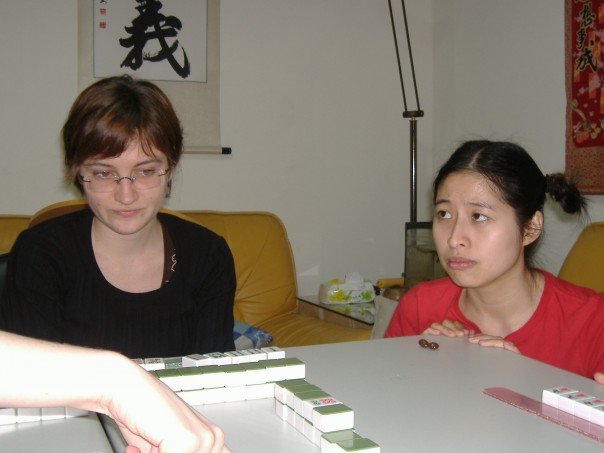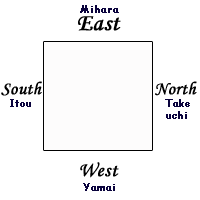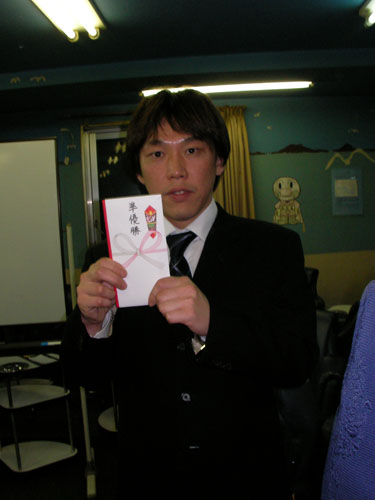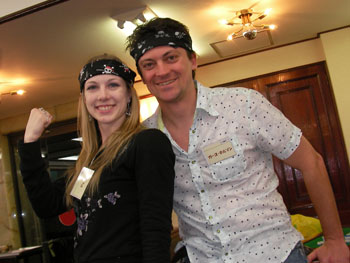February 27, 2007

In Garthe's Hands #8
How are you all holding up remembering all those hands? We've covered quite a few already and I wouldn't be surprised if some of you are wondering how much longer I can keep coming up with new hands to throw at you. Don't worry; after 14 of them now, we're almost halfway through! Hang in there. The hands I'll be covering the next few issues will be comparatively rare, but can make for impressive scores when they're pulled off. Today let's cover two more that are closely related to each other: Mixed Outside Hand, and Pure Outside Hand.
Mixed Outside Hand (Terminals and Honors): 1-2 Hand Points
A Mixed Outside Hand, known as "Chanta" in Japanese will be a hand consisting only of runs or triples and a head that use a 1, 9 or letter tile. It is a bit of a converse to Simples. So 9-9-9 in Bamboos would be a useful group, as would 1-2-3 in Grands. Pairs or triples of Honor tiles can also be used. Concealed, it's fairly rare so it's worth two Hand Points. Stealing tiles from discards will bump it down to one Hand Point. It's a good idea not to steal tiles without good reason. A couple of possible reasons might be; perhaps the tile is almost all gone, or, there are other Hand points in the hand too so it's an expensive hand and worth stealing for. One of the other hands that will often work in well with this hand is Three Color Runs. Because runs all have to be at one extreme or the other, it will often just work out that there's one in each suit. One of the reasons it's so unusual, at least for me, is that I drop stray 1 and 9 tiles early in the hand as a matter of course. At the beginning of a hand I may have 6-8-9 in a suit and discard the 9 without noticing that I have a lot of terminal tiles in all the suits. I've shot myself in the foot right on the starting line. So lately I do try to pay attention as I'm first grabbing all my tiles to see if I have a lot of the terminals and letter tiles. This is good for noticing whether or not you have a good shot at the All Terminals Limit hand too.
Pure Outside Hand (All Terminal Sets): 2-3 Hand Points
Pure Outside Hand is Mixed Outside Hand's big brother and you may be able to guess from the difference in the names that what makes it different is that it doesn't allow the use of Honor Tiles. So all groups and the head must contain a 1 or 9. This is considerably more difficult, so it's a 3 pointer. Though, once again, stealing tiles will knock it down a point to 2. And once again, Three Color Runs is even more likely with this hand as the kinds of groups get more concentrated without the letter tiles. And once again and again, it's one of those things that needs to be noticed early if there is to be any chance of going for it. The Japanese name for this hand is "Junchan".
One thing to note especially regarding these hands, is how bad an idea it might be sometimes to use Reach together with them. If the wait happens to be a "good" one, for example 23 waiting for the 1or 4, there is a huge risk of having to win on the wrong tile. Reaching and then letting the cheaper tile go by without winning will knock the hand into the "Missed hand" category and the only option for winning anymore will be drawing the winning tile. So a hand that might have been huge with 6 points may wilt all the way down to just one point for the Reach.
Here are some examples:
Mixed Outside Hand ex.1

Just 1000/1500 points. Useful perhaps at the end of the game if one just needed to win a hand to end the game.
Mixed Outside Hand ex.2

Let's say the player reached and some unlucky soul threw the red dragon: the hand points are Reach, Red Dragon, Triple Colored Runs, Terminal/letter groups for a total of six hand points making it 18,000/12,000 points!
Pure Outside Hand ex.1

Bumped because ⑨ was the lucky dragon, this would be a 12,000/8000 point hand
Pure Outside Hand ex. 2

This is an example of the situation where declaring Reach might have been disastrous. If the 4 had come, the hand would simply be Reach and Peace for a grand total of 2900/2000 points. The fact that the player waited quietly for the 1 to come out adds Triple Color Runs and Terminal Groups into the mix for an actually grand total of 18,000/12,000 points.
To post comments to this column, click here.






























